Magda M. Olchawska's Blog, page 4
May 27, 2021
On My Zero Waste Journey Off, I Go (Part 1)
Disclaimer: This post might contain affiliate links.
I was aware of a zero-waste lifestyle for years. I also knew about the consequences of my wasteful shopping and spending habits. However, I never understood the scale of waste I’ve been producing. So, when the hard facts hit me, I committed to pivoting my life towards a less wasteful path. At the end of 2020, I made a promise to myself that 2021 wasn’t only going to be the year of saying “YES” to myself but also the year of shifting my lifestyle towards conscious and more sustainable new daily habits.
I’m not going to go entirely to zero waste because, in all honesty, I don’t think I can. However, I’m aspiring to make significant changes to my daily routine that will set a positive pattern, which, in the long run, will produce much less waste.
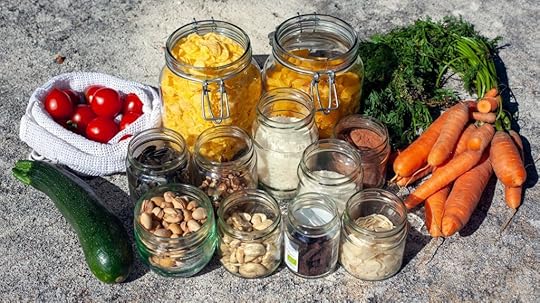 Photo by Jasmin Sessler on Unsplash
Photo by Jasmin Sessler on UnsplashI’m happy to report that thinking about waste has already started paying off.
When I go shopping, I try to buy fewer products wrapped up in plastic packaging. The UK loves plastic; they even put cucumbers in plastic, which I find ridiculous. Luckily, cucumbers plastic-free do exist in the smaller shops and at farmers markets.I consciously choose fruits and veggies that aren’t pre-packed in plastic. Before my awakening, I didn’t really pay much attention; I would just toss everything and anything in the trolley.If I buy takeaway food, I try to bring my containers with me (I usually buy street food at the markets). If I don’t have the container, the guilt often stops me from shopping. (I know it might be silly but seeing a non-recyclable container and knowing how long it will take to decompose, gives me shivers.)Of course, I carry my bottle of water and a coffee cup in my backpack.I got metal strews recently, so if a place offers me a straw, I can refuse and reach out for mine. I recently refused to buy takeaway ice cream when the woman behind the counter told me that my takeaway ice cream container wasn’t new, and by definition, unhygienic (Bullshit!!!) and she wanted to give me another one. I felt pretty confident saying “no”. On the other hand, she couldn’t really understand my reasoning (arguing with people over single-use plastic is something I may need to get used to). I said: “Because I can have something, it doesn’t mean I must, and I want to.” There was no ice cream for the teenage M. and no business for the ice cream place. I’m pretty sure I’m not going back there. I don’t want to support this company if they don’t think about the long term environmental impact.Recently I started making two shopping lists—one for a zero-waste shop and another for the regular shop.My goal for the next few weeks is to make sure that, when buying meat, my hubby uses containers instead of single-use plastics, and I would also like to replace wrapping up plastic and paper when buying cheese with possibly beeswax food wrap. I will see how that goes. I guess it all depends on the goodwill of the shopkeepers.
I’ve replaced a lot of my waste in the bathroom, you can read about that here, but I’m in constant search for replacing more of my bathroom products. So, the plan for the next few weeks (my deadline for this project is the end of June) is to replace:
Sanitary pads – I’ve been using organic/biodegradable, but it still creates waste and takes ages to degrade. I have ordered the Mooncup, so I will have to see if I’m actually happy using it. If not, I have other alternatives to choose from.Shampoo – I bought a new shampoo from the zero-waste shop. The sales assistant said that it was the most popular, so I guess that it may work. The verdict is still on that. My local zero-waste shop has a few choices, so I’ll keep trying until I can settle on one and be satisfied. I genuinely hope this is going to work and the shampoo bottle problem will be solved.Cotton Buds – we have been using the paper once, but it always comes in the plastic box, which bothers me immensely. So, I’m looking at the options at the moment and planning to try out the reusable cotton budsTry out the toothpaste in jars and see if we can use it. (comfort, price, taste all needs to be considered) For the moment, we are using the only toothpaste that comes in recycled packaging, but as we all know at this point, recycling isn’t the best solution.RecapMy plan for the next 5-6 weeks is to implement the changes above and see what is possible and doable. Replacing the bathroom products shouldn’t be an issue as long as I can find the right shampoo.
Not using packaging for buying products or using my own packaging might cause some issues, especially now during the pandemic. Still, maybe by educating the shop owners (I know them both, we shop locally in a Polish and Italian shop), I would make progress.
AimI aim to create as little non-recyclable waste as possible. I know recycling isn’t the ideal answer to our waste problems, but it is better to recycle something than put it in a landfill and leave it to decompose for 500 years.
ResearchI’m also planning to research the following:
Find a new bank, which is in sync with my sustainability values.Find the best composting solution for our current living conditions.Find a filter for our washing machine.If you have any suggestions, please share. I would love to hear from you. I will update you in July on how my progress is evolving.
 https://www.patreon.com/magdaolchawska
https://www.patreon.com/magdaolchawskaThe post On My Zero Waste Journey Off, I Go (Part 1) appeared first on Ecotopia Universe.
May 21, 2021
What Does Zero Waste Lifestyle Mean?
Disclaimer: some of the links are affiliated.
The goal of a zero-waste lifestyle is to produce as little trash as possible. To accomplish that, people have to reduce (their consumption), reuse (as many materials/ parts/components of products as possible), recycle (making sure the recycled items indeed go into recycling facilities without contaminating other products. In short, no “wish cycling“; if the label on the bin says that something isn’t recycled, it means it isn’t.). At the moment, only 9% of plastic gets recycled. So, this is definitely something to think about before buying anything plastic.
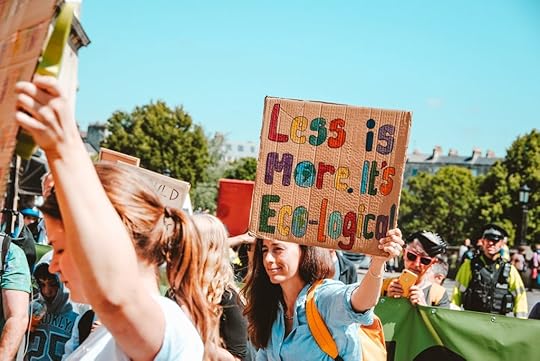 Photo by Hello I’m Nik on Unsplash
Photo by Hello I’m Nik on UnsplashThe current economic and production model introduced during the industrial revolution (over 200 years ago) of taking, making and disposing is still going strong and is deeply intertwined with the outdated linear economic system. Luckily, movements such as zero-waste push forward circularity, while highlighting the astronomical prices and dangers of wastefulness.
The concept of a zero-waste lifestyle can be trackback to the beginning of civilization when every item was used until it was unusable no more.
The modern zero-waste lifestyle focuses on prompting behaviour change on an individual level to prevent waste. Producing as little waste as possible benefits:
you, as your savings rate goes up because you aren’t in a cycle of spending just for the sake of it and buying,environment because you aren’t tossing away rubbish and unused/unwanted items, adding to the landfill or moving the responsibility of discarding your unloved items onto charities (charities cannot sell the stuff they already have, so most likely your things are sent to a third world country to sit in the landfill there, polluting the water and nature of another country).Becoming a conscious consumer is an integral part of implementing a zero-waste lifestyle, which firmly pushes towards breaking the consumption cycle, focusing on quality and longevity instead of quantity, trends, and fast fashion.
The zero-waste movement inhabits the following set of beliefs:
Rethink – Do you really need to buy this product? Don’t let the marketers make you believe you need more of everything! What are you going to do with the product once you are done with it?Refuse – if there is something you don’t need, say NO (free magazines, newspapers, drinks, single used plastics or anything that is disposable and not really needed).Reduce – Reduce the number of things you have and shift your focus towards long-lasting products. Keep in mind that charities have a hard time selling items.Repair – repair what you can; don’t toss something away, just because it has a light stain. I recently fixed my socks, and the whole process wasn’t only fun but very rewarding too. Repairing items such as dishwasher and washing machines are essential steps towards creating a sustainable circular lifestyle and economy.Reuse – for instance, jars or bottles. My mum always uses bottles to make juice or wine. She uses jars for jams, salads, pickles, etc. My local package-free shop collects jars and bottles. What can you do with your packaging? How can you reuse it?Rote – compost your food. It’s hard to do it in the city but composting pick-up services have been established in some countries, and you could also try vermiculture composting (I’ll write more about this once I try it out myself).Recycle – a zero-waste lifestyle aims to have as little recycling as possible. However, if you have to recycle, make sure the packaging is clean and goes to the right bin.The reduce, reuse and recycle rules/concept were first popularized in the late-1970s. In 2013, Bea Johnson introduced the world to Five Rs (check out her book “Zero Waste Home: The Ultimate Guide to Simplifying Your Life”). The rest of the R’s were added by the Zero-Waste Movement/Community.
Choosing Zero-Waste Lifestyle is choosing an intentional lifestyle, in which a priority isn’t to use up, misuse and abuse the finite natural resources Earth provides us with. Instead, investing in long-lasting products, package-free, ethical, local and compost, whenever you can, is what the lifestyle stands for.
Of course, it’s very challenging to go zero-waste in our modern complex world. Still, even if every one of us reduces 10% of our waste, it would be a fantastic start towards a healthier and more sustainable future for us all.
Most of all, don’t underestimate your “small”, local actions. Positive and impactful change always starts small. For instance, this week, I finally made my way to our nearest package-free shop, some 20-25 mins drive from us (I know it’s still driving, but I figured since I was in the neighbourhood, I would pop in).
I bought a 5l container for the laundry liquid (I had the container with me), bought metal strews for the 3 of us (baby M. doesn’t need one yet), and brushes to clean dishes. I also looked around and compared prices. I’m not going to go completely waste-free all of a sudden. However, I’m surely going to do my best to cut down on our waste without bankrupting our family in the process.
Going zero-waste or even cutting down on it is challenging because the concept challenges the status quo of our consumer debt-driven culture.
I’m not encouraging anyone to go zero-waste as I know how hard it is, especially when you have kids and live in the city. But making minor monthly or weekly adjustments will help establish good habits that globally can make a massive difference for the sustainability of life on this planet. No, we cannot all move to Mars and live in a colony, so let’s try to focus on saving and treasuring what we already have.
The post What Does Zero Waste Lifestyle Mean? appeared first on Ecotopia Universe.
May 13, 2021
The Circular Economy Model (part 2)
The Circular Economy Model (part 2)
I recommend reading “The Circular Economy Model Part 1” before reading this article.
 Photo by Joel & Jasmin Førestbird on Unsplash
Photo by Joel & Jasmin Førestbird on UnsplashThe macroeconomic benefits from transitioning from linear to a circular economy will be positively felt across the society and will comprise of:
Eliminating dependency on finite resources. Instead of constantly producing new items, re-using products and materials will help to regenerate the natural system rather than degrade it. For instance: land regeneration is costly, and that doesn’t even include the alternative costs of losing biodiversity or unique landscapes. A circular economy regenerates the land by returning biological materials into the soil when their natural circle has ended. Designing out waste and pollution during the production process. For example: if Europe committed to a circular economy by 2030, they could halve carbon dioxide emissions. The UK could reduce greenhouse gas emissions by 7.4 million tonnes per annum by keeping organic waste out of landfills. (via Ellen MacArthur Foundation). Innovation – replacing the linear model will create many innovative and creative opportunities for people to develop technological solutions for a sustainable economy, improving efficiency in using new/re-used materials, and generating new ways of consuming energy. Growth – increased growth will be achieved by applying circular activities (upcycling products, re-using materials and repairing) and lower production costs through the utilization of products. The circular way of production and consumption will be mirrored in consumers’ demand (demand will change and shift towards repair and longevity), pricing (pricing will have to adjust to reflect shifting customers’ demands) and supply (the supply chain won’t be relying on new materials but re-used materials and parts). Based on detailed product-level modelling in the EU alone, for medium-lived products (mobile phones, washing machines), annual net material cost savings could amount to $630 billion. For fast-moving consumer goods, such as household cleaning products, the potential savings could go up to $700 billion globally.Creating more robust employment – the circular economy model will be built on a service-based economy, generating new jobs across various sectors.Lowering the production costs as there is a lesser need for new materials.Constructing new profit streams, such as leasing high-end products rather than buying them, repairing, buying back parts of the products or the products themselves, re-selling refurbished products, re-selling used parts, etc.Reducing exposure to materials from volatile parts of the world (war, natural disaster, human rights abuse).Demand for new business sectors will grow, i.e. collection and reverse logistics, product marketers and sales platforms, parts and component remanufacturing, refurbishment, rentals and leasing. The business will have to learn and adjust towards building a lifetime relationship between customers and the company providing the product because they will start providing long-term services, not products only.A circular economy won’t only benefit small and large business/organisations but also individuals:
It will offer more considerable disposable income. The cost of products and services will be reduced.People will have less unproductive time, such as finding a replacement for the broken product, collection, or someone who could fix the issue. The company people buy their product from will provide all the logistics.Customers will have much better choices regarding products, often tailored to meet their needs. It will be easier to choose an ethical company that promotes a circular economic model in an honest way.The products won’t fail as often, which will bring down ownership costs, while delivering higher convenience at the same time.Health costs could lower significantly, and many of the pollution-related illnesses and deaths could be avoided.In practice of course, shifting from linear to circular economy isn’t going to be easy and will take enormous human effort. From the operational point of view, a lot will have to change, including business models, accounting practices, delivery of goods, aftercare, training, profit share, etc.
Many linear economic model elements will need to change to bring the desired effect; changing just one piece won’t change anything.
At the moment, we are in a perfect situation when the economy, technology and social factors are coming together to push for change. The challenge is to make sure that the circular economy can go mainstream and scale up fast enough for that change to become a reality that benefits everyone, not only the “chosen” few.
The post The Circular Economy Model (part 2) appeared first on Ecotopia Universe.
April 30, 2021
The Circular Economy Model (Part 1)
Our world currently operates in the linear economic model, primarily based on the consumption of finite resources Earth provides us with. The resources are taken out of Earth and turned into products, which at the end of the cycle are disposed of (wasted) and never used again. Just think about all the products you have bought and never used or all the products you have purchased and only used once. For instance, fast fashion massively adds to heaps of waste.
Unfortunately, the linear economic model isn’t working any longer, and if we are to preserve life on Earth, a sustainable approach to the world’s economy is a must.
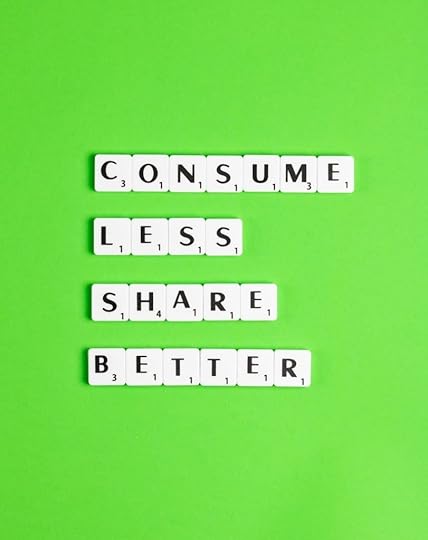 Photo by Edward Howell on Unsplash
Photo by Edward Howell on UnsplashThe circular economy model focuses on how the product is produced and establishes if society and the environment can benefit from it. In the circular economy model, it’s essential to know how the materials will be used in the product flow: how and where the energy is coming from to produce the product and how it will benefit the planet once its lifecycle ends.
The main principle, on which the circular economy is based and designed is that nothing is wasted, and every product and its component is either: reused or re-purposed, once the product cycle is finished, recycling is the last resort in the circular economy model.
As such, the circular economy focuses on building a healthy relationship between the resources we use to make products and longevity of those products and materials. For the circular economy to be thriving on the global scale, it needs to be functional and practical for large and small businesses, as well as organizations and individuals on every level (internationally, nationally, locally).
The circular economy is based on three principles:1. Getting rid of waste and pollution during the production process: reducing greenhouse gases and hazardous substances, air, land and water pollution, and structural waste such as traffic congestion.
2. Reusing the same products and materials for different purposes (using things, instead of using them up). In practice, it means developing products durability, reusage of materials, remanufacturing and recycling to ensure the products, materials and parts are in constant use.
3. Regenerating natural system: using renewable energies during the production process, instead of fossil fuels and returning nutrients to the soil at the end of the product cycle.
The circular economy model values energy and labour as well as materials.The circular system uses bio-based materials, and avoids using non-renewable resources, by pioneering many different uses of that material during the cycle between the economy and natural system.
Think about how you could develop ideas to reuse the materials you use daily, instead of ending their cycle immediately in a rubbish bin.
Example of how circular economy can/does exist in our everyday life:
Buying products that are known for their prolonged lifespan. Yes, they might cost a bit more, but it will save you money in the long run. If I shop for clothes, I don’t shy from buying more expensive items when I know that the quality is much better, meaning I’ll be able to wear them for longer than fast-fashion items. Besides, usually, if you spend small amounts of money on pieces of clothing, you don’t treasure them as much as you do when you spend more. It’s in human nature; if something is cheap or free, we don’t think it has much value. Reuse and redistribute items you have and don’t use; sell or buy second hand. I don’t only have clothes in mind, but electronics too. I recently purchased a refurbished keyboard for my iPod, and I’m planning on continuing this tradition. My granny always fixed clothes, and that included tights as well. Of course, the everyday realities of living in a communist country were very different to a democratic country. The reuse aspect of the economy was driven by the limited access to goods.Try to find a second life for your products, re-design them. When I was a kid, clothes that weren’t useable any longer were re-sawn or used as cleaning cloths for furniture’s, kitchen table and shoes. Not buying everything that we think we need to use only once. When I was growing up, neighbours used to borrow stuff from one another. Hardly anyone had a collection of perfect tools lying around. Everything and anything can be borrowed nowadays. And even of this writing, H&M in the UK is lending people suits for job interviews. This is pretty sweet, and ladies and gentlemen, H&M is onto something. So, watch that space.Returning used materials and components to the natural environment as nutrients. Once the product or material cycle has ended, it should be returned to nature instead of creating heaps of waste—for example, organic waste can go back straight into the soil. What else that you use can go right back to the soil?Think about how you could use ideas incorporated in the circular economy model to improve your everyday life or your business, while focusing on becoming less wasteful and more mindful about the negative effects the traditional linear economy has on our planet and our daily lives.
The post The Circular Economy Model (Part 1) appeared first on Ecotopia Universe.
April 23, 2021
What Does Sustainability Mean?
 https://amzn.to/3sDIW46
https://amzn.to/3sDIW46The post What Does Sustainability Mean? appeared first on Ecotopia Universe.
April 16, 2021
Can Circular Economy Redesign Our Future?
March 26, 2021
Biodegradable, Compostable and Bioplastic: What Does It All Mean?
Biodegradable products are made from materials that will decompose with the help of microorganisms such as bacteria or fungi, with or without oxygen. In short, it means that an item is going to decomposed without leaving any pollution behind.
In reality, every product that we use will ultimately break down. However, the question is how long it will take for it to do so. It certainly takes an awfully long time for plastic packaging to decompose.
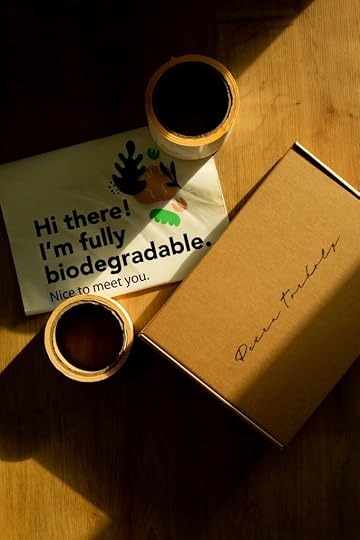 Photo by Marcell Viragh on Unsplash
Photo by Marcell Viragh on UnsplashHence scientist came up with biodegradable plastic to fight plastic pollution.
Biodegradable plastics are usually made with renewable raw materials, microorganism, petrochemicals (no so good for the environment) or a combination of all three.
If biodegradable items get buried in a landfill without exposure to bacteria, oxygen, heat or light, they would never decompose, just like single-use plastic.
So it’s vital to research how the biodegradable product we plan to buy will be disposed of or recycled.
A much better replacement for biodegradable plastic is compostable or bioplastics, which aren’t made from fossil fuels but plant-based materials such as bamboo or sugarcane. Bioplastics and compostable materials break down into water, oxygen and compost.
Compostable packaging is often used for takeaway foods. Even if the food gets mixed up with compostable plastic, everything can be disposed of together, as food is compostable as well.
Compostable goods are fully biodegradable; nevertheless, for the process to occur, the right composting environment needs to be provided, which will allow those products to break down within 90 days, leaving the soil beautifully nurtured. Awesome result!!!
If you have a compost heap or bin at home, keep in mind that only a tiny fraction of compostable plastic can be placed in either. Most of the compostable plastic will need high temperature and humidity to break down, which can only occur in the industrial composter.
For bioplastic to break down in natural conditions, microorganisms need to be introduced in the process. In the natural environment, the product will break down into the water, carbon dioxide and other minerals allowing the earth to absorb all the elements, leaving nothing toxic behind.
Some products that will naturally biodegrade in a domestic compost heap or in nature won’t break down in generic landfills because of a lack of bacteria, water or light for the process to take place.
Keep in mind that whether you choose biodegradable, compostable or bioplastic products, they will need to be provided with the right environment to break down, and some of the products require a professional composting facility. Always make sure you know how to recycle any of those products.
In my opinion, the best thing we, consumers, can do is to avoid buying single-use plastic and opt for reusable options while aiming at gravitating towards naturally biodegradable products, which will reduce waste, and pollution.
Natural biodegradable materials include:
– Human and animal excreta,
– Plant products such as natural rubber, paper, wood, leaves, cotton, wool, etc
– Dead remains of living organisms,
– Kitchen waste,
– Agricultural waste.
The post Biodegradable, Compostable and Bioplastic: What Does It All Mean? appeared first on Ecotopia Universe.
March 18, 2021
What Does Sustainability Mean?
In 1983 former Norwegian prime minister Gro Harlem Brundtland was appointed by the United Nations to run World Commission on Environment and Development. After four years of research and consultations, the commission published a report titled “Our Common Future”, which defined sustainable development as “development that meets the needs of the present without compromising future generations’ ability to meet their own needs.”
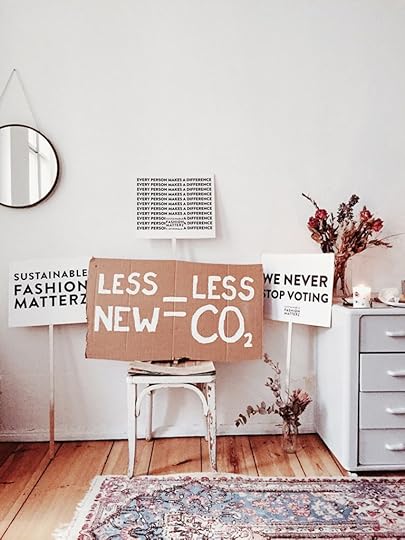 Photo by Cherie Birkner on Unsplash
Photo by Cherie Birkner on UnsplashIn short, sustainability is the ability to survive, in our case on planet Earth, continually. In the 21st century, when people or media talk about sustainability, they mean the coexistence of us, humans, with Earth’s biosphere.
Sustainability comprises of three pillars: economic (profits), environmental (planet) and social (people). Sustainability acknowledges that ecological, social and economic aspects need to come together to create long-lasting prosperity.
Sustainability’s main objective is to keep balance within the natural resources that allow the cohabitation between humans and other species on Earth, while the planet supports that coexistence.
We often use sustainability to describe actions people take to reduce pressure on natural resources without draining them. Items described as sustainable can be reusable; don’t use chemicals and plastic that hurt the planet during the production process and don’t add to non-recyclable waste.
When describing sustainable improvements, we often talk about:
over-exploitation of natural resources (Producing items that are non-recyclable, use a lot of natural resources to be produced and add waste.),lifestyle (Lifestyle changes, choices people make that can contribute to building a sustainable future.), investments (Are the companies you invest in align with your sustainable values? Are they making progressive, sustainable changes? Maybe investing in local businesses is more in keeping with your values?),minimalism (No more unnecessary purchasing.),technological development (How technology can influence our sustainable future? Electric cars, renewable energy sources, etc.),energy (Natural and renewable.),manufacturing of goods (How are the goods you purchase manufactured? How far those goods travel before they reach you, the customer? How environmentally friendly/sustainable is the production process?).Economic Sustainability means that communities worldwide have access to the financial resources they need to meet their needs, such as secure income. Unfortunately, this isn’t the case in many parts of the world.
Social Sustainability means that human rights and basic needs are met. People have easy access to enough resources to keep their families and communities healthy and secure with leaders that represent all people and protect their personal, labour and cultural rights from discrimination. Regrettably, countries, instead of progressing on social sustainability, are regressing in many places around the world, including Europe.
Sustainability, as an idea was developed as a response to public dissatisfaction with the corporate world’s short-term profit-driven goals that kept investors happy, while the environment around the globe was deteriorating.
Despite the high upfront costs, businesses have started shifting focus from short-term profits to sustainable solutions. At the end of the day, what is the point of making profits if our planet is unlivable?
However, we still have to remember that sustainability and sustainable solutions need to work for all of us, not only for the citizens of wealthy countries. We are in the ecological crisis together, and our solutions need to be implemented across the globe equally.
You might have noticed that “sustainability” is often plastered all over the mainstream media. Celebrities love patronizing us, “little folk” and demand mindfulness and sustainability in our everyday lives. In reality, when you have the money, being sustainable (I know some very wealthy people who, apart from driving Tesla, care very little about sustainability and Tesla is just a status item for them.) is an easy choice. However, for the rest of us, sustainability often means introducing small changes and taking small steps to become a part of the solution that will significantly impact the environment around us (i.e. swap your bottle soap for a bar of soap. On average shower gel bottle takes 450 years to decompose!).
For me, sustainability means that my daily actions shouldn’t damage or leave unrepairable destruction behind. However, as most of us, I’m doing my sustainability bit on a budget, and the swaps and improved sustainable choices I introduce are small but consistent. Besides, changing your life, focusing on sustainability after years of careless wastefulness, requires building new, long-lasting habits. I believe that small but consistent steps should be taken to ensure our internal system and lifestyle aren’t overwhelmed and defaults back to old habits.
The minor changes every one of us can quickly introduce without breaking the bank include:
Buying loose fruits and vegetables, instead of the packed ones.Cutting down on eating dairy and meat products.Cooking more at home, instead of ordering take-aways.Using public transport, walk or cycle whenever it’s possible.Introducing a minimalistic lifestyle to your household and buy only what you need and what you know you will keep for a long time. Before you purchase anything, ask yourself if you will be comfortable keeping this thing in your life.Buying second-hand whenever possible or swap clothes with friends.Trying to replace plastic with bioplastic, glass and aluminum.Repairing items instead of replacing them.Let me know how you get along and don’t forget to share your sustainable swaps that are good for the environment as well as for your pocket.
The post What Does Sustainability Mean? appeared first on Ecotopia Universe.
March 1, 2021
How to Tackle Bathroom Plastic Waste?
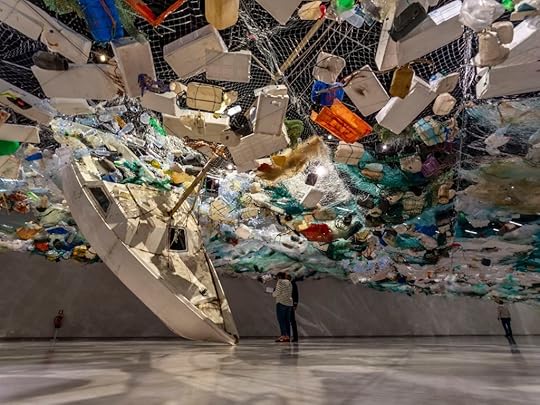 Photo by Martijn Baudoin on Unsplash
Photo by Martijn Baudoin on UnsplashOver our lifetime, each of us creates on average 512 kgs of bathroom waste. Some of those items, such as contact lenses, will never decompose.
I’ve been trying to ditch plastic from my bathroom products for years now. Unfortunately, it feels like a Sisyphus job since most of the products I buy come in plastic. I honestly try to shop for products in glass containers. Still, it’s close to impossible in some instances to find a replacement that is good quality and won’t send me to a poor house down the line (the astronomical costs of products in non-plastic containers are significant factors stopping the public from replacing plastic).
As for me, the simplest product to replace was soap/shower gel. The trickiest part is to find a soap bar that doesn’t have an extra layer of plastic wrapped up around it. In practice, it means that I need to be fully aware and mindful, even while shopping for soap. It takes up to 450 years for a shower gel bottle to decompose, so replacing plastic containers for soap bars should be the first thing every one of us does.
The shampoo has been pretty tricky for me to replace. The bar shampoos I tried weren’t good. I tried several brands, and all were as bad as the previous one, leaving my hair tangled and in a state of despair. As of this writing, the only solution I can see to the shampoo bottles problem is for the public to aggressively lobby companies to set up refillable stations in shops and supermarkets or use bottle collection/refilling services.
The naysayers will point out that this kind of switch and upgrade will cost lots of money, and there is no infrastructure to implement such a change. But the reality of leaving behind a legacy of empty non-compostable shampoo bottles isn’t something we should be neglecting. Companies must do more in helping to turn that nightmare of an ecological disaster into a workable solution. Necessity is the mother of all invention, and I have faith that even with substantial investments in sustainable solutions, companies can and will turn a profit.
Other bathroom products that can be easily replaced are toothbrushes, wet wipes and razors. Toothbrushes can be swapped for electric toothbrushes with recyclable heads, and small flannels can replace wet wipes. The metal and bamboo razors should be used instead of disposable razors. It takes 100 years for a wet wipe to decompose and 400 for a toothbrush, so it should be a no brainer that we all swap those products.
Since the political and corporate powers are re-thinking our economic model, or at least I strongly hope so, re-directing the economy and jobs towards a greener and more sustainable economy and solutions should be the primary objective of governments and the corporate world in the post-Covid economy.
Shampoos, lotions, toners and facial creams must all come in refillable bottles. All shops, without an exemption, need to offer affordable refilling facilities without cheeky, hidden costs the customers have to cover on their end. As long as refilling won’t become easily accessible and part of our shopping routine, I feel it will be hard to combat the plastic waste from our bathrooms.
Another issue, which is much less visible in our everyday bathroom products, is the plastic microbeads used in toothpaste, shower gel and cosmetic products. Once washed off, they cause a severe threat to marine wildlife. Hence buying products without microbeads is always on my priority list. Keep microbeads on your radar, and if unsure, check the ingredients. Sometimes the companies use fancy words to confuse us. If I buy a new product that includes confusing ingredients section, I usually put it away. From my experience, I can say that companies that produce organic products typically have nothing to hide and whatever ingredients they use it’s written on the label.
As of this writing (Feb. 2021, I’ll be re-visiting and updating this post at the end of the year.) I use facial creams in glass jars or metal tubes, I have an electric toothbrush for everyone but baby M. who has a biodegradable one, and of course, we use soap bars.
This year’s plan is to replace facial wash and toner, shampoo, toothpaste, and body lotion. For now, we are using the only toothpaste that comes in a recyclable tube, but still, it’s plastic.
How will my switching go? I have no idea because it’s not easy to find a good quality product that is also kind to the environment. I also don’t know how expensive this change will be since the products that don’t come in plastic containers still tend to be pretty pricy.
I know that some people are skilled and determined enough to make their own products, but that is out of the question for me. I’ve travelled that road before and ended up buying gazillion of ingredients, mostly in plastic bottles; however hard I tried to make the washing-up liquid work, I couldn’t crack the secret of it. In support of my experiment, my hubby tried his hardest to clean the dishes with whatever I made, but it was unusable.
Conscious and mindful shopping sounds like a lot of work. Still, we have no choice and cannot afford not to become mindful consumers, who make smart choices with their money. Everyone in an instant can implement small changes and adjustments in their lives without having to wait for the politicians to pass laws and corporations to amend their wasteful ways. The time to act is now.
As for me, I’m on the lookout for affordable, good quality products that will cause much less damage and, in the long run, create a positive, long-lasting impact.
I’ll keep you updated on my plastic-free bathroom project so stay tuned.
UPDATE APRIL 2021Disclaimer
The links below are part of the Amazon Affiliate Program, covering some of the website’s running costs. However, all the products I recommend, I use myself daily.
I swapped my facial wash in a plastic bottle for one from Neal’s Yard
I swapped my make up removal in a plastic bottle for a Sukin Super Greens Detoxifying Cleansing Oil. I never used a cleansing oil before but I’m pretty excited about experimenting.
I started making my own facial toner: to a glass of hot water, I add the green tea and aloe vera, it’s refreshing and totally wast free. I bought amber glass spray bottles with a trigger pump but you can either use an upcycled jar or glass bottle (Neal’s Yard bottles are an idea for that).
I have also decided to try Mooju Reusable Makeup Remover Pads, which so far have been working wonderfully. There was so many of them that I shared some with my sister.
I also swapped my disposable razor for a metal one, it is a tad heavy but works beautifully. With the razor, I also got the Astra blades, which my grandfather used as well.
I’m still planning to stop using toothpaste in a tube and I’m looking for a good shampoo replacement, so please if you have any recommendations do let me know.
The post How to Tackle Bathroom Plastic Waste? appeared first on Ecotopia Universe.
February 9, 2021
What Are the Dangers of Mindless Consumption?
Take a deep breath, close your eyes and imagine a world without greed, corruption and pollution. Take another deep breath and indulge in this visualization for a few moments.
When you feel ready to move on, imagine a world where mindless consumption isn’t rewarded with likes, hearts, thumbs, or spikes in sales. Can you see that? How does it make you feel?
Mindless consumption is like indulgence in the most horrifying session of eating crisps, chocolate bars, cookies, white bread with sugar on top and drinking five different sodas simultaneously. Majority of us wouldn’t be able to last long, conducting such a revolting experiment. But when it comes to buying what we don’t need or spending money we don’t have, majority don’t see such a toxic lifestyle problematic.
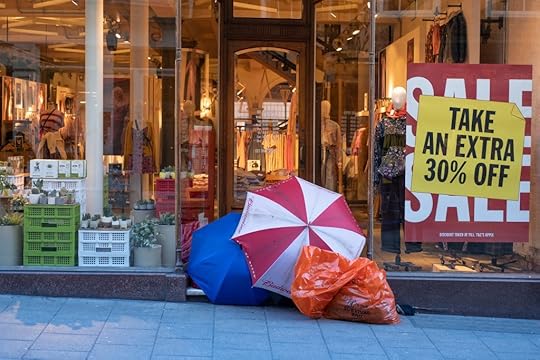 Photo by Dan Burton on Unsplash
Photo by Dan Burton on UnsplashBefore the pandemic people roamed shops aimlessly, strolling along big, brightly lit shopping centres with one objective in mind: to find a good deal. Once the deal was located, the pleasure pheromones got to work. Often leaving a hole in the buyer’s wallet and actively adding to the pollution and environmental deterioration. Don’t waste your precious time, pointlessly walking around the shopping centres looking for a deal. Life isn’t that long; imagine all those amazing things you could have been doing in that time instead of shopping.
Build a new habit of shopping with purpose, and only when you need it.
Pushing society towards mindless consumption is the priority for marketers, celebrities, corporations, and, believe it or not, governments.
Suppose we follow the not so gentle nudge towards consumption. In that case, we only harm ourselves and those around us by adding to global pollution, air quality degradation and a prospect of Earth becoming uninhabitable for humans one day. Where are we going to go if that will come to pass? Mars? Really? Just imagine living in a permanent lockdown because this is the only way the life on Mars would look like. We still may be some years away before Star Trek reality kicks in. However, as long as we cannot easily planet hop, respecting and looking after what we have on Earth should be our collective priority.
I realize that our existence is burdened by consumption: adverts, TV shows, social standards and social pressure; all those one-of-a-kind Black Friday, Cyber Monday, Bunny Rabbits B-day deals are created for shoppers to spend. Mindless consumption is often responsible for masses of debt. When the times are good and jobs easy to come by, with lots of hard work debt can be paid back, but when the times are lean just like now… this is when the real troubles begin. Buying anything on credit that isn’t essential or long-lasting works against the customers.
I love shopping when the sale is on. It’s a great way to save money, but mindless shopping or using the money I don’t have to shop does “only” keep the corporations repeating the same lie: that customer demand forces them to destroy our resources.
Nobody needs 15 pairs of jeans or five different bikes; buying a new iPhone every year is bonkers. Social status buys won’t save anyone from heat, starvation and weather unpredictability. Buying heaps of food that end up in a rubbish bin, because there is only so much a person can eat, also adds to Earth’s ecological degradation. Food production uses up a lot of natural resources. If you buy products coming as a by-product of deforestation, you are actively supporting the annihilation of our planet.
Mindless consumption is a dangerous habit, but luckily we, the consumers, can deal with that without having to wait for governments to pass laws and corporations to amend their ways. We just need to be vocal at demanding sustainability, possibility to repair goods (train young people in the trades of fixing things) and longevity of items we buy.
In reality, people need very little to survive, be happy and thrive. Mindless consumption is nowhere near that list. Globally, we need a shift that rejects consumption-driven culture and lifestyle. There is not much time anymore to debate and set goals. Just look at the tons of rubbish, mostly plastic that are everywhere. I’m more than confident that sending our garbage to Mars is not a viable option.
If you want to have a realistic pick at what our future may look like watch “Wall-E”. Currently, the trajectory humanity has embarked on worryingly closely resembles the plot of this excellent film. Just remember, only chosen few may make to Axiom, a spaceship drifting aimlessly in space for eternity. Well, if there was only a way, we could all contribute to preventing global pollution and ecological collapse… anyone… anything…I’m all ears.
Quick TipsTry to eliminate as much disposable plastic from your household as you can.Try to buy second-hand items or fix ones you already have, instead of immediately disposing of them.Only shop for things you need, not only because something is cheap but may rathe have no or little use for you.The post What Are the Dangers of Mindless Consumption? appeared first on Ecotopia Universe.




